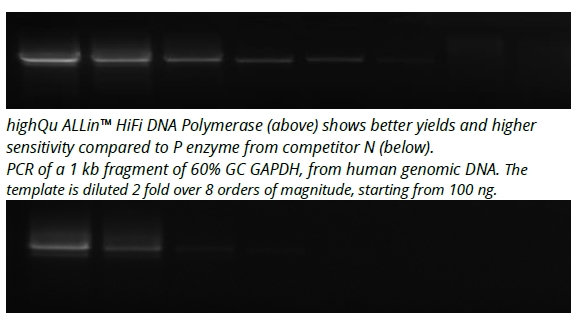Infectious disease diagnostics made easy: ALLin Isothermal 1-Step RNA Amplification Kit for RNA detection
Applications
- Virus RNA detection, SARS-CoV-2 detection
- Isothermal one step RNA amplification at elevated temperature
- RT-LAMP – reverse transcription loop-mediated isothermal amplification
Benefits
- Efficient 30 minutes 1 Step RNA amplification at 55-70°C temperature
- ALLin™ format, supplied with water and a dye for fast real-time detection
- Bst DNA polymerase with strong strand displacement activity
- Thermostable reverse transcriptase blended with RNase inhibitor
- Robust on complex RNA templates and crude samples
ALLin™ Isothermal 1Step RNA Amplification Kit enables detection of < 5 target RNA molecules in a short time of 30 minutes without the use of PCR cycler. An RT5 Mix, the blend of a thermostable reverse transcriptase and highly efficient RNase Inhibitor is included in the kit to initially synthesize cDNA from RNA templates.
The cDNA is amplified by Bst polymerase. Kit includes a 2X master mix with optimized high-performance buffer, dNTPs and a recombinant Bst Polymerase large fragment having strong 5’ - 3’ strand displacement activity and efficient 5’-3’ polymerase activity working at 55-70°C. The Polymerase has neither 5’ - 3’ nor 3’ - 5’ exonuclease activity and retains only minor reverse transcription activity.
The kit also includes PCR water; only templates and primers have to be supplied by the user. Quantitative Fluorescent Dye, 20X is included for an optional use, for a real-time detection in FAM channel on any qPCR cycler. ALLin™ Isothermal 1Step RNA Amplification Kit is a tool of choice for isothermal amplification of RNA templates and such applications like RT LAMP, with an additional advantage of higher temperature reactions, what makes amplification of complex and GC rich templates more efficient.
Technical characteristics of Bst DNA Polymerase large fragment:
- Strong 5’ - 3’ strand displacement activity
- 5’-3’ polymerase activity
- No 5’ - 3’ exonuclease activity
- No 3’ - 5’ exonuclease (proofreading) activity
- Minor reverse transcriptase activity
- Optimal amplification temperature is 65°C.
- Working temperature range is 55-70°C.
- The Bst enzyme is inactivated in 10 minutes at 80°C.
- RT5 Mix includes thermostable reverse transcriptase (modified MMuLV) working at high temperatures and a thermostable RNase inhibitor protecting template RNA from degradation.
- Optimal 1Step RT amplification reaction time is 30 minutes, if needed, the reaction can be performed 30 to 60 minutes.
- Quantitative Fluorescent Dye has the excitation max. at 482 nm and emission max. at 512 nm.
The use of this product in certain applications may be covered by patents. The user has to analyse all applicable Limited Use Label Licenses and may need licensing for certain cases.
Tips for the best direct PCR or crude sample PCR amplification results:
If direct PCR amplification does not work, reduce the sample input amount, for example use less of bacterial colony material or less of tissue.
- For some samples you might need performing a simple lysis with proteinase K, lysozyme or commercially available direct PCR amplification lysis buffers.
- Try different dilutions of the lysed sample for the PCR amplification.
- Choose primers with high specificity and efficiency for the target sequence to ensure successful amplification.
- Use only the hot-start DNA polymerase or master mix for the best amplification result when working with crude samples.
- Determine the optimal annealing temperature by conducting a temperature gradient PCR to enhance primer binding and specificity.
- Extend the denaturation step to ensure complete DNA denaturation, especially in crude samples with potentially more inhibitors that can be degraded when heating.
- Include positive control (known DNA template/primers) and negative controls (no template) to validate the PCR amplification results.
- Download Protocol and Specifications - Product Insert ALLin™ Isothermal 1Step RNA Amplification Kit
- Ask for a Sample today
- Have technical questions? Contact us
- Download a list of Publications mentioning highQu products
- Or see how others use our products at bioz.com or google scholar
- Download Protocol and Specifications - Product Insert ALLin™ Isothermal 1Step RNA Amplification Kit
- Download MSDS ALLin™ Isothermal 1Step RNA Amplification Kit
- Need a lot-specific Certificate of Analysis? E-mail us at info@highQu.com
- Want custom formulations or bulk sizes? E-mail us at info@highQu.com, and check our OEM offers
- Have more specific questions? Contact us
- Download Protocol and Specifications - Product Insert ALLin™ Isothermal 1Step RNA Amplification Kit
- Download MSDS ALLin™ Isothermal 1Step RNA Amplification Kit
- Download highQu Catalogue of Premium Research Tools
- Download a list of Publications mentioning highQu products
- Or see how others use our products at bioz.com or google scholar
- Download Product Pricelist (DE 2021)
- Download all highQu Product Inserts and MSDS sheets
- Have questions? Contact us






